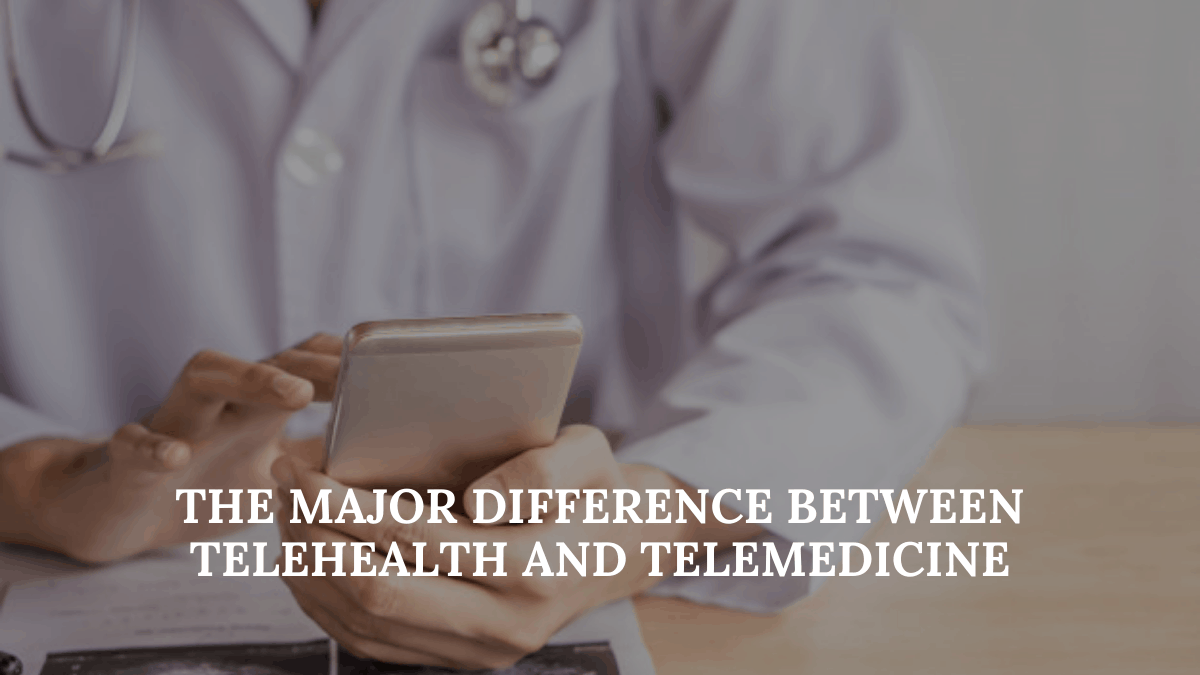
The Major Difference between Telehealth and Telemedicine
At first glance, both telehealth and telemedicine seem very similar terms, that however, cannot be any further from the truth. Today the fields of Mobile IT health, digital health and telemedicine are changing so rapidly, that it is hard to settle on one accurate definition for these terms, hence you will see both Telemedicine and Telehealth being used interchangeably.
Both terms consist of very similar services which include patient monitoring, e-health, medical education, patient consultation etc. If you really want to get to technical with the terms then Telemedicine is a subset of Telehealth.
Telehealth, on the other hand is much broader term in scope which includes all telecommunication services that offer or engage in health care. Telemedicine refers only to clinical services.
Here’s a definition that could clear your mind on the concept:
Telemedicine refers to traditional clinical diagnosis and screening provided by technology, whereas Telehealth encompasses many different types of diagnosis, management and education. Telehealth concerns itself with many different range of telemedicine services which include both clinical and non-clinical services.
Telehealth being the more popular term can be found in general health care services, while Telemedicine deals specifically with a clinician that provides a very specific kind of health service.
Examples of Telehealth
- A video conferencing platform for consultation and education
- A health app that alerts people of impending outbreak
- Fit Bits that monitor your pulse and heart rate
Example of Telemedicine
- An app that helps physicians treat their patients remotely via video conferencing
- A software that allows patients to send photos of a rash or a mole that has been bothering them to their doctors.
- An app that schedules appointments with doctors within minutes.
As you can see Telemedicine is simply a small part of telehealth. Telemedicine has become even more popular and is being widely consumed thanks to the recent COVID-19 outbreak. If anything, it has proved its worth in times of emergency and will gain further validity once the pandemic is defeated.
DENmaar’sTeleHealth Services
At DENmaar, our telehealth solution offers both patients and providers with a communication technology that allows the access and management of health care services from homes of patients or the practices of doctors. This tele-conferencing feature allows practitioners to attend to their patients, on their computer screens, where-in they can consult and serve their clients without having to make them wait in their clinics or making them transit long distances.
All you have to do to access our feature, whether you are a provider or patient, is to sign up to our app and avail our telepsych feature.
Learn More
Pros and Cons of Tele-Nursing
We all want our healthcare to be both effective in its treatment and affordable in its cost. When telehealth is implemented efficiently, both of the above aspects become easier to achieve. We can see improvements in patient satisfaction as well as management of healthcare amidst your own organization.
An advance in communication technology is only making things better for the telehealth industry. Smartphones today are faster and actually smart. Stronger internet connections are ensuring care is rendered uninterrupted. Today, telehealth is so much more than simply calling up your nurse to explain your symptoms.
In this article, we will look at Tele-nursing, its pros, and its cons. So without much further ado, let’s jump right into the meat of this article.
Pros and Cons of Tele-Nursing
Better management of Chronic Conditions
RPM aka Remote patient monitoring has replaced traditional clinical visits today to manage chronic conditions like diabetes and COPD. In RPM there’s less fragmentation of care when a patient lapses with their responsibilities. With fewer contact, there are less clinical visits and readmissions. In one study, participants of the ‘behavioral health intervention telehealth program’ experienced less hospital admissions than the patients who did not participate.
Increased Access to Care
Patients who live in rural areas are the most significant beneficiaries of telehealth. Rural areas have always received the harsh end of a stick when it came to accessing to health care. Tele-health changed all of that. Now, rural areas, thanks to the strong internet connection and better smartphones have access to healthcare.
Avoid Risk
In the context of the recent COVID-19 outbreak, Telehealth provides a great opportunity for doctors to still consult their patients via videoconferencing while adhering to the mandatory discipline of social distancing.
Save Time
With telehealth, patients don’t have to travel long distances to meet their doctors. They don’t have to wait in long lines as well. Tele-health saves time which is precious to both doctors and patients.
Cons
Some Visits are Necessary
Although telehealth is crucial in providing convenient health care to patients, it still cannot make up for physical consultation which is necessary for most situations. Doctors cannot feel your stomach through telehealth, they cannot swab your throat, or listen discerningly to your lungs or heartbeat.
Licensing issues
Licensing issues restrict nurses from providing health care to patients that do not fall in their state. Nurses can only practice and provide care in the states that permit them to practice health care.
Reimbursement
Insurance coverage for telehealth services is still shoddy and needs a lot of work. Only 21 states today require private insurers to cover telehealth services. Medicaid programs vary from state to state in paying for services offered by nurses through telehealth.
DENmaar’s TeleHealth Services
At DENmaar, our telehealth solution offers both patients and providers with a communication technology that allows the access and management of health care services from homes of patients or the practices of doctors. This teleconferencing feature allows practitioners to attend to their patients, on their computer screens, where-in they can consult and serve their clients without having to make them wait in their clinics or making them transit long distances.
Learn More
Cigna Embraces Telehealth Technology
Cigna has finally launched its own Telehealth services to offer its 12 million members access to primary health care services. The insurer has partnered with Florida based Telehealth service provider MDlIVE to bring its services to their insurers.
This isn’t the first time MDlIVE has partnered with an insurance company, Humana and Blue Cross Blue Shield, came before Cigna. They have however, partnered with Cigna before to provide urgent care through their Telehealth services.
The move has pushed Cigna into a newly popular arena of advanced healthcare technology. Amazon and Walmart are also rumored to be bringing in their own telehealth services in the market. The telehealth service means to improve access to rural areas for better healthcare, and provide specialty care without any hassle. If recent stats are anything to go by, then the younger generation are already ignoring traditional methods of physical consultations and opting for such online services instead.
What is Telehealth technology?
Telehealth provides patients with the tool to consult with their doctors from the comfort of their respective abodes. It allows for face to face communication without compromising on the concept of physical distancing. Videoconferencing, Fit bits, Apple watches are all examples of telehealth technology
The Benefits of Telehealth include:
- • Making Healthcare accessible for rural and isolated communities.
- • Access to behavioral and other medical specialists
- • Making services available for communities and people with limited mobility, or transportation options
- • Improved communication between doctors and patients
- • Improved self-management of health care practice
For many traditional health care professionals, Tele-health is still an uncharted territory. Venturing into something this unknown to them can seem intimidating. However, most Tele Health services today are easy to use and can be implemented with only minor level training.
DENmaar’s TeleHealth Services
At DENmaar, our telehealth solution offers both patients and providers with a communication technology that allows the access and management of health care services from homes of patients or the practices of doctors. This tele-conferencing feature allows practitioners to attend to their patients, on their computer screens, where-in they can consult and serve their clients without having to make them wait in their clinics or making them transit long distances.
All you have to do to access our feature, whether you are a provider or patient, is to sign up to our app and avail our telepsych feature.
Learn More
How Telehealth Technology is Transforming Modern Healthcare
Most people are not even aware, but Telehealth technology has been around since the 1980’s. Yes! That’s how old the technology is. Since then Telehealth has grown to become a revolutionary tech that can convey medical information throughout the globe in real-time. Medical professionals can now provide services to individuals and areas that previously had no access to health care.
Now that the entire world is reeling in the face of an unexpected pandemic outbreak, Telehealth has become more important than ever. It has already proven its mettle in saving countless lives by making individuals abode by the golden rules of social distancing that our current situation demands.
In this article, we will be looking at the 5 ways in which Telehealth technology is transforming modern healthcare.
So without much further ado, let’s get started
Spreading Expertise in All Areas
Telehealth has graced rural areas with its presence. These areas have suffered a lot due to inadequate health care. Usually, these areas have their own community doctor to take care of an entire community. However, he might not have the expertise to deal with all kinds of medical conditions. Telehealth act as a convenient assisting tool in this regard.
Let’s say a community doctor is dealing with a patient with stroke, with very little expertise in the field. With the help of Telehealth, he can consult an expert over video calls and take better care of the patient suffering from a stroke.
Helping People with Limited Access to Care
A majority of the world we inhabit still lives in conditions of great suffering and lack the basic privilege of proper healthcare. Before telehealth, deaths and aggravated medical conditions were typical in rural and underdeveloped regions of our planet due to the absence of expert medical personnel. Thanks to telehealth, there is no excuse anymore for healthcare professionals to transmit care over the internet, which can lead to many lives being saved.
It is Inexpensive
With telehealth, patients are rewarded with the benefit of affordable healthcare. Telehealth technology like Fit bit and Apple watches are now relatively affordable and can provide great health benefits to users. Insurance companies along with Medicare and Medicaid are also now reimbursing the use of telehealth, which has made Telehealth more trustworthy amongst insured individuals.
Pervasive Adoption
With the current pandemic, telehealth is likely to be adopted by all forms of healthcare channels, making it even more popular than it was before. Remote home care will quickly replace long wait times at clinics. More telehealth treatment options will be reimbursed by our healthcare system.
DENmaar’s TeleHealth Services
At DENmaar, our telehealth solution offers both patients and providers with a communication technology that allows the access and management of health care services from homes of patients or the practices of doctors. This tele-conferencing feature allows practitioners to attend to their patients, on their computer screens, where-in they can consult and serve their clients without having to make them wait in their clinics or making them transit long distances.
All you have to do to access our feature, whether you are a provider or patient, is to sign up to our app and avail our telepsych feature.
Learn More
The Fundamentals of Telehealth for COVID-19
The recent novel coronavirus outbreak has cemented the fundamental nature of Telehealth in our health care system. It has quickly proven to be a lifesaving innovation in health care technology and many providers are making sure they facilitate their patients with TeleHealth services for continued, safe provision of health care.
The federal government has already expanded on the concept of TeleHealth services, deeming it to be the perfect tool in the face of COVID – 19. Tele-Health succeeds in the practice of healthcare provision by implementing the principals of social distancing and isolation, both of which are important to decimate the super contagious virus.
Telehealth provides patients with the tool to consult with their doctors from the comfort of their respective abodes. It allows for face to face communication without compromising on the concept of physical distancing.
Apart from social distancing, TELEHEALTH also offers the following benefits to both providers and patients.
The Benefits of Telehealth include:
- • Making Healthcare accessible for rural and isolated communities.
- • Access to behavioral and other medical specialists
- • Making services available for communities and people with limited mobility, or transportation options
- • Improved communication between doctors and patients
- • Improved self-management of health care practice
For many traditional health care professionals, Telehealth is still uncharted territory. Venturing into something this unknown to them can seem intimidating. However, most TeleHealth services today are easy to use and can be implemented with only minor level training.
As of now, there are no legal certifications required by practitioners to provide TeleHealth services to their clients. However, there are many professional behavioral health associations that demand some level of competence in the part of providers to better implement the new service.
As some states are relaxing licensing requirements, that is not the case with all states. Be sure to check with your local licensing boards on the formalities and rules that apply to your practice. Make sure that telehealth and cross-state services are covered under your policy before rendering the service.
DENmaar’s TeleHealth Services
At DENmaar, our telehealth solution offers both patients and providers with a communication technology that allows the access and management of health care services from homes of patients or the practices of doctors. This teleconferencing feature allows practitioners to attend to their patients, on their computer screens, where-in they can consult and serve their clients without having to make them wait in their clinics or making them transit long distances.
All you have to do to access our feature, whether you are a provider or patient, is to sign up to our app and avail our telepsych feature.
Telehealth for Patients
Our telehealth feature offers patients with the following benefits
- • Easy communication with doctors and nurses online
- • Prescription refill requests
- • Schedule appointments
- • Review Test Results
Telehealth for Providers
- • Counseling Patients Online
- • Provide healthcare advice and services in remote and rural areas
- • Schedule appointment or post-appointment reminders
- • Review and deliver test results
